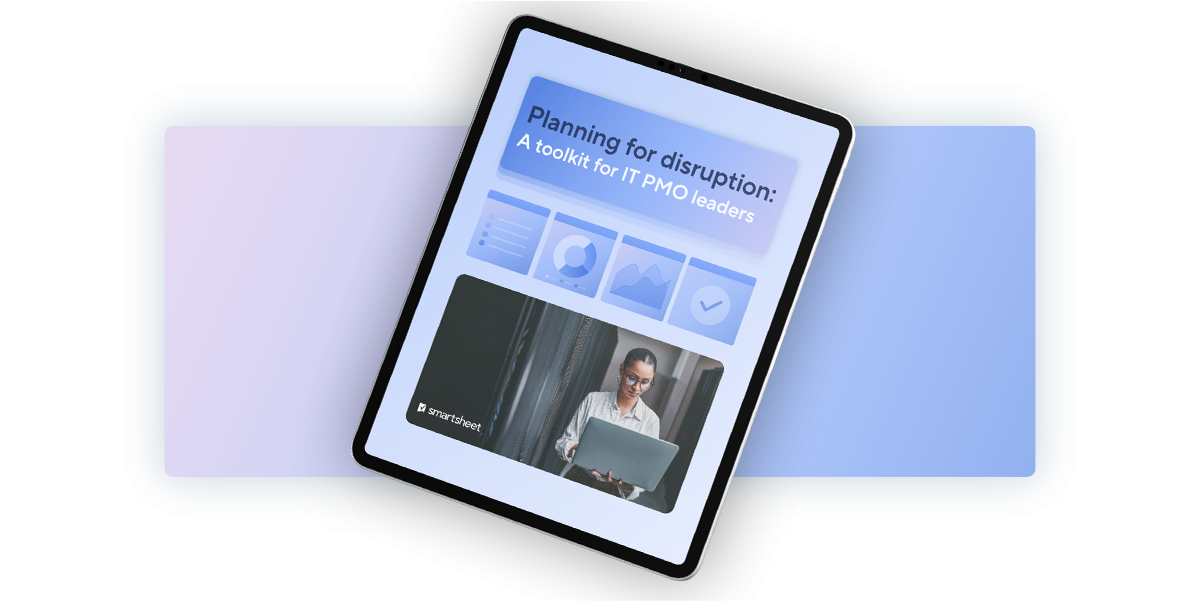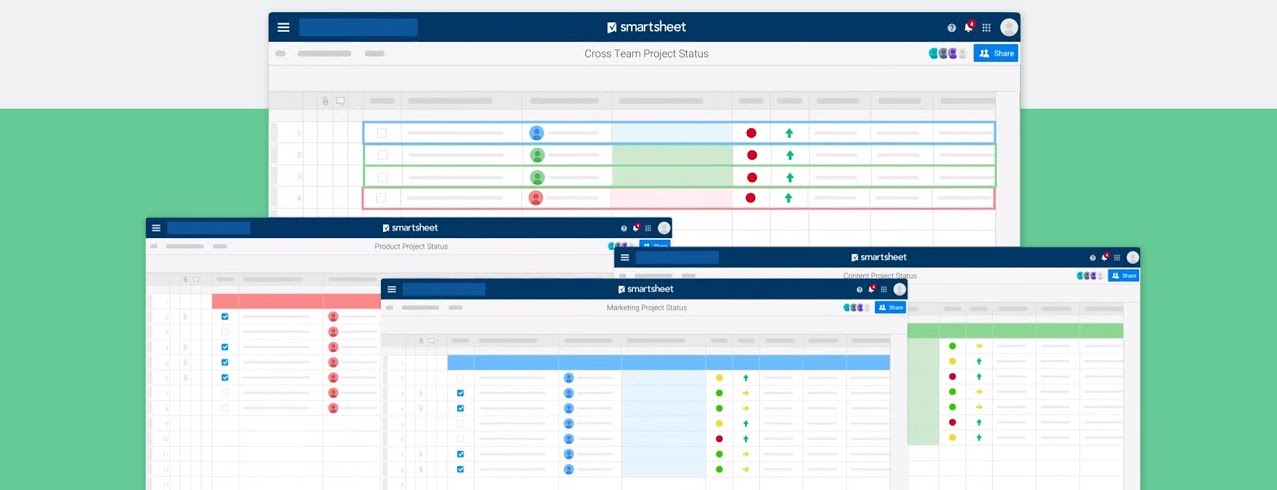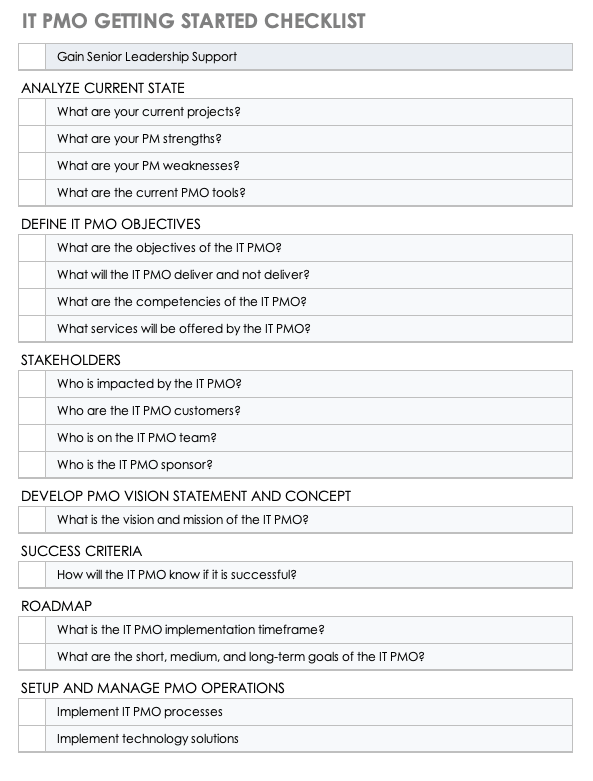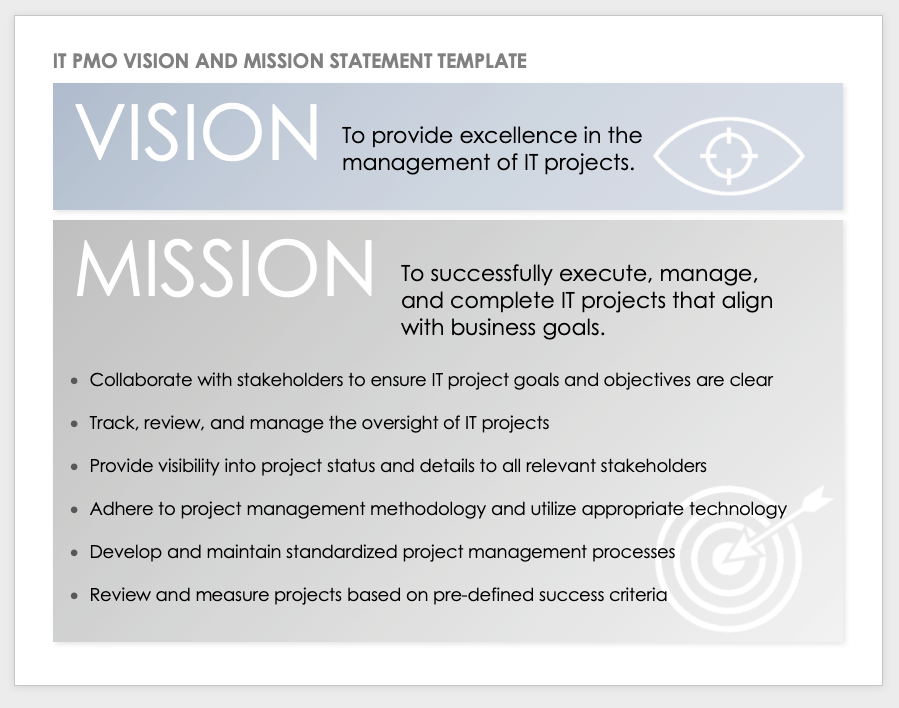What Is IT PMO?
An information technology project management office (IT PMO) provides project oversight and rules of engagement to manage technology-related projects effectively. The IT PMO is the keeper of project management (PM) best practices, processes, resources, and relevant tools.
For many organizations, PMOs originate in IT departments; this is because a considerable number of IT projects require structure. For example, projects that employ the software development lifecycle (SDLC) — in which planning, requirements exploration, design, development, testing, deployment/implementation, and project closeout are all integral elements — necessitate IT-related structure. Often overseen by a chief information officer (CIO), today’s IT PMO applies modern project management and portfolio management practices with a laser-like focus on project cost, schedule, and resource allocation.
The PMO, not to be confused with the product management office, is also widely known as the program management office, project support group, project management center of excellence (PMCOE), project office, or project portfolio management office. Additionally, many organizations broaden the PMO beyond IT into the enterprise program management office (EPMO) or project portfolio management office (PPMO).
Free Toolkit
Empower Your IT PMO to Thrive
Master the demands of a fast-paced IT environment with this essential toolkit.

Discover practical strategies for demand intake, portfolio prioritization, and project planning, complete with actionable templates, expert tips, and real-life examples to help your IT PMO tackle today’s biggest challenges.
What Is the PMO Abbreviation in the IT Industry?
The project management office (PMO) is referred to as the IT PMO when focused on technology-related projects.
What Is the Difference Between a PMO and a PM?
A PMO provides oversight and guidance for project management processes, best practice methodologies, project scope, and risk management associated with multiple projects. According to the Project Management Institute (PMI), “PMOs enable strategic change in organizations.”
By contrast, PM is an area of expertise within the PMO that manages a project from idea to completion, focusing on time and budget. Once a company approves and plans a project, the project manager manages its delivery.
What Are the Different Types of PMOs?
PMOs come in many different forms based on company size, business needs, and strategic goals. They can be external or internal facing to support various stakeholders or customers. Some help to standardize processes and share knowledge and tools, while others take on the alignment of projects with an organization’s goals.
Here are the methods companies use to organize an internal PMO:
- Individual PMO: These support single project planning, documentation, and execution.
- Departmental or Divisional PMO: These integrate and coordinate multiple projects to meet a specific department’s goals. IT PMO is an example of a departmental PMO.
- Corporate PMO: High-level strategic project planning that aligns enterprise strategies and organizational goals with resource allocation and capacity management for organization-wide project management.
Based on the level of control and influence your business requires, there are three types of PMOs:
- Supporting PMOs: A supporting PMO offers the minimum level of control. The supporting PMO acts as an information repository for project management expertise, templates, tools, training, and management frameworks.
- Controlling PMOs: The controlling PMO introduces more compliance requirements or controls for projects. It demands the adoption of specific work tools, templates, and governance requirements.
- Directing PMOs: Directing PMOs furnish projects with full control directives, governance, compliance, and management.
IT PMO versus Enterprise PMO
Many corporations have two separate PMO structures. An IT PMO is an IT entity for managing all IT-related projects. By contrast, a business PMO or enterprise PMO (EPMO) provides cross-functional project management for multiple department functions, such as accounting, human resources, manufacturing, marketing, and logistics.
Why Is an IT PMO Important?
As companies strive to keep pace with rapid growth and technology changes in every aspect of business, the IT PMO provides relevant, available, and proven support. An IT PMO initiative typically becomes a company priority when any of the following materializes:
- Objectives and goals go unmet.
- Major business events occur, such as mergers or acquisitions.
- Important milestones occur, such as Y2K.
- Management desires increased control and visibility.
- Projects continuously fail.
- Costs become unmanageable and impact revenue.
- Standardized PM best practices and decision frameworks are lacking.
- Resource allocation problems arise.
- There is a need to balance governance with project delivery demands.
An IT PMO is the organizational structure that develops PM strategy and implements all aspects of IT project management. The PMO processes ensure the following:
- People and activities align with goals.
- Projects are on target, on time, and under budget.
- The company focuses on the right projects.
- The company mitigates risk.
- Customer and stakeholder impact are clear.
- The company allocates resources properly.
- Project dependencies are clear.
Deliver work at scale through consistency and automation.
Smartsheet Control Center is a project and portfolio management tool that builds on the core value of Smartsheet to deliver consistency and visibility at scale by automating project creation.
With Control Center, you can manage the entire lifecycle of your program and all of the projects and processes that are part of it.
The Structure of an IT PMO
Structuring an effective IT PMO requires a flexible, organized, and strategically aligned process. It also depends on hiring, training, mentoring, and communicating with the right people.
IT PMOs often require the support of the IT department, PMO director or manager, IT project managers, software engineers, data analysts, change managers, training staff, and support staff. The scope of a project dictates which skills and team members are most suitable.
IT PMO Roles
Led by a PMO director or manager, the staff should complement strategic goals. Generally, candidates should be strategic thinkers, financially savvy, organized, flexible, and process oriented. Additionally, members should be skilled at both teamwork and communication.
What Is the Role of a PMO in the IT Industry?
An IT PMO is structured to provide guidance, timelines, resources, and tools in order to move projects toward success. The office commonly handles multiple projects at a strategic level.
The most mature PMOs provide the following:
- Support: A PMO allows teams to be successful by reducing bureaucracy and managing expectations. It also offers training, coaching, and mentoring.
- Knowledge: Efficiency comes from sharing knowledge about what has and has not worked. A PMO centralizes knowledge for repeatability.
- History and Traceability: A PMO manages historical records and ongoing documentation in a transparent and accessible format to support future decisions.
- Governance: A PMO maintains accountability at all levels through appropriate staffing, program structuring, and auditing.
Characteristics of a Great IT PMO
While the complexity of an IT PMO differs from business to business, the elements for success remain constant. IT PMOs enjoy success when an efficient structure and high-quality leadership come together. Here are some of the characteristics of a great IT PMO:
- Aligns with enterprise strategies and focuses on process improvement
- Responds to change and shifts in strategy
- Shares information and best practices, and controls processes
- Provides templates, tools, and resources
- Fosters training, mentoring, and coaching for high-level performance
- Possesses technical acumen
- Has PMI-certified staff
Finally, an excellent IT PMO earns company-wide support by establishing transparency into project activities, results, and continuous improvement.
IT PMO Processes and Strategy
IT PMOs are populated by talented people who benefit from a proven process and a business-aligned strategy. IT PMOs provide milestones, defined processes, tools, and communication that encourage cooperation, shared vision, and success. They also identify and respond to difficulties by troubleshooting and changing course when necessary.
As part of an overall goal of cost saving and efficiency, an IT PMO is a catalyst for the efficient use of resources, optimal communication, and significant error reduction. Through repeatable processes and shared information, an IT PMO improves projects, so a company can achieve timely, well-budgeted deliveries.
There are many methodologies and frameworks that an IT PMO may adopt and evangelize, including the following:
For a complete guide to project management methodologies, read “How to Choose the Right Project Management Methodology.”
IT PMO Metrics
Great PMOs measure results and continually improve — this is important in order to prove department value and avoid the cost-center stigma. Because improvement is an ongoing factor in the PMO strategy, choosing the right metrics to measure is critical.
Measurements provide proof that things are working as they should, but they also highlight improvement opportunities. KPIs, along with measures that evaluate the impact on people and culture, are essential. Here are some necessary IT PMO measurements:
- Statistical Analysis: This paints a picture of how PMO processes improve outcomes, timelines, and deliverables. Here are some examples of stats that an IT PMO would want to measure:
- Number of PMO-managed projects vs. non-PMO-managed projects completed in a year
- Estimated cost and resource allocation vs. actual deliverable cost
- Milestone/timeline impact
- Return on investment (ROI)
- Surveys of Team Members: Consider stakeholders by surveying staff members regarding the PMO’s impact on their work. Here are some examples of questions you might ask your staff:
- In what ways can the company improve communication or processes?
- How does the PMO impact your job satisfaction?
- What is the value of coaching and mentoring?
Benefits of an IT PMO
PMOs provide the structure to keep everyone apprised of risks, decisions, changes, conflicts, and timelines. Today’s IT projects are rising in both number and complexity, and stakeholders (from the C-suite to support staff) have different levels of involvement and interest. According to the Project Management Institute, 80 percent of champions (i.e., high-performing companies) have a PMO. Here are some of the benefits of an IT PMO:
- Decreased overall project costs
- Centralized and consistent work, rather than more costly silos
- Increased alignment of project portfolios with corporate objectives
- Shared resources to prevent duplicate efforts
- Increased productivity
- Improved project visibility
- Accelerated project delivery
- Unified processes and methodologies
- Reduced project risk, error, abandonment, and failure
- Improved connection with customers and increased customer satisfaction
Challenges of an IT PMO
According to research by PM Solutions, a company’s management typically questions the value of its IT PMO the second most among all its departments. The research also found the following:
- Management regards 50 percent of PMO processes as overhead.
- Forty-two percent of PMOs experience organizational resistance to change.
- Thirty-five percent of project managers have inadequate skills for a PMO.
One reason for these PMO challenges is that many organizations implement a PMO without conducting a business needs assessment, or without adequate preparation and resource allocation. You must take an informed look at risks and benefits and allocate appropriate training, tools, and staff before launching a PMO. For example, PM frameworks have their own vocabulary. In order to succeed, staff members must attend training on the relevant standardized framework or methodology.
PMOs also experience problems because they may initially promote quick wins and successes, but these gains may be unsustainable, especially if PMs revert to their day jobs once the initial project is complete. This lack of focus leads to the diminishment of initial stakeholder excitement and buy-in.
The ability to reap the overall value of an IT PMO takes time, flexibility, prioritization, and focus. It also requires the introduction of appropriate processes that mature and evolve, bringing long-term value to the business.
How to Determine If You Need an IT PMO?
To determine if an IT PMO is right for your organization, take a look at your operational structure. Alan Zucker, Founding Principal of Project Management Essentials, suggests the following:
“Ask yourself and the leadership team if you need a PMO. Also ask what function you want it to serve. There are three primary PMO functions, which can overlap: supportive, controlling, and directive PMOs. Far too often, PMOs form without forethought. Here are questions that can help frame this discussion:
- What problem(s) does our organization have in terms of executing projects?
- Are we selecting the right projects?
- Are project teams successful in their execution?
- What actionable information do we currently not have that a PMO could provide?
- What decisions would we like to make that a PMO would enable?
- How would the enterprise be different if there were a PMO?”
How Do You Set Up an It PMO?
To get your IT PMO up and running, Zucker recommends engaging with a skilled facilitator: “An industry expert will take the stakeholders through the process of identifying their pain points and the desired ‘to be’ state of the organization. This process will help define the type of PMO the organization needs.”
Getting Started with an IT PMO Checklist
If you’re struggling to get your IT PMO started, this free IT PMO checklist will help. The checklist guides you through a series of questions and action items that will lead you from analyzing your current state to measuring success.
Download the Getting Started with an IT PMO Checklist
IT PMO Vision and Mission Statement Template
A vision and mission statement will help the IT PMO communicate its unique purpose, functions, and goals to staff, stakeholders, and other business members. Use this template to declare your vision and mission.
Download IT PMO Vision and Mission Statement Template
IT PMO Best Practices
An IT PMO handles a variety of projects, large and small. The ability to optimize PMO operations, gain credibility, and manage projects without friction, delays, cost overruns, or challenges requires standard but impactful best practices.
- Centralized Communication: Centralized communication minimizes problems through transparent collaboration and information sharing that benefit teams and upper management.
- Training, Coaching, and Mentoring: These activities increase the value of the team and the effectiveness of PMO processes.
- PMO Templates and Tools: Pre-defined templates and appropriate project management tools simplify communication, resource allocation, and training.
- Collaborative Resource Management: Reduce waste and error with a standard resource management process and information transparency.
- Standardized Methodology or Framework: When everyone is adhering to an agreed-upon best practice framework, you ensure that project management is consistent and that everyone is speaking the same language.
- Defined Roles and Responsibilities: Clearly defining and communicating roles allows you to straightforwardly assign responsibility and accountability.
IT PMO Tools
One of the most effective strategies for IT PMO adoption and success is choosing and implementing the right frameworks, people, processes, and tools. A tool should support the ability to track, report, manage change, and follow an IT project throughout its lifecycle.
Successful implementation and high levels of user adoption drive consistency and can accelerate project delivery by supporting and enforcing the PMO’s standardized processes. Tools increase productivity and improve project visibility for the team and C-suite management, enabling better decision making. Consider the following PMO tool features and characteristics:
- Ease of implementation and use
- Timelines and progress tracking
- Collaboration capabilities
- Visibility through Gantt charts, Kanban cards, and other views
- File storage
- Automation and change management
- Project archiving
- Reporting and dashboards
- Mobile access
- Resource and capacity management
The Future of IT PMO
Digital transformation is driving a need for companies to move more quickly while maintaining quality. This means that all teams must optimize processes and tools to get more done, faster.
Whether your organization is implementing a mobile application, AI for customer service, or a new accounting system, much of the work falls to IT, since technology is at the core of departmental efficiency.
The expectation is that the PMO will evolve into an integrated model that works across all business units. Gartner estimates that by 2030, 80 percent of today's project management (PM) discipline will be eliminated as artificial intelligence (AI) takes on traditional PM functions, such as data collection, tracking, and reporting, according to Gartner, Inc [1]. We believe that a movement to apply AI means that PMOs will rely on advanced technology to handle some of the essential traditional PM activities and that project managers can move their focus to more strategic initiatives.
Zucker predicts that “As more and more organizations adopt Agile practices, traditional PMOs that historically focus on governance and control will be forced to adapt and change. PMOs have a role in large, Agile enterprises, but they will need to take a collaborative approach that focuses on the continuous delivery of value.”
[1] Gartner Press Release “Gartner Says 80 Percent of Today’s Project Management Tasks Will Be Eliminated by 2030 as Artificial Intelligence Takes Over,” 20 March 2019. https://www.gartner.com/en/newsroom/press-releases/2019-03-20-gartner-says-80-percent-of-today-s-project-management
Optimize IT PMO with Smartsheet for Project Management
From simple task management and project planning to complex resource and portfolio management, Smartsheet helps you improve collaboration and increase work velocity -- empowering you to get more done.
The Smartsheet platform makes it easy to plan, capture, manage, and report on work from anywhere, helping your team be more effective and get more done. Report on key metrics and get real-time visibility into work as it happens with roll-up reports, dashboards, and automated workflows built to keep your team connected and informed.
When teams have clarity into the work getting done, there’s no telling how much more they can accomplish in the same amount of time. Try Smartsheet for free, today.
Any articles, templates, or information provided by Smartsheet on the website are for reference only. While we strive to keep the information up to date and correct, we make no representations or warranties of any kind, express or implied, about the completeness, accuracy, reliability, suitability, or availability with respect to the website or the information, articles, templates, or related graphics contained on the website. Any reliance you place on such information is therefore strictly at your own risk.
These templates are provided as samples only. These templates are in no way meant as legal or compliance advice. Users of these templates must determine what information is necessary and needed to accomplish their objectives.



